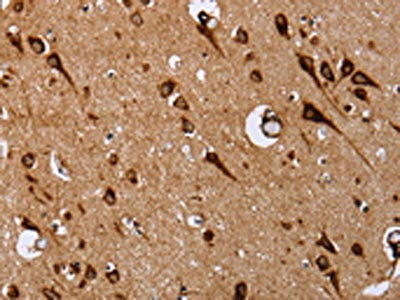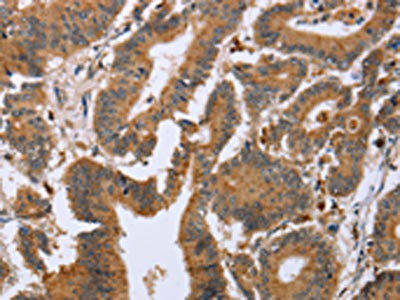Description
| Antibody Name: | EPDR1 Antibody (PACO16260) |
| Antibody SKU: | PACO16260 |
| Size: | 50ul |
| Host Species: | Rabbit |
| Tested Applications: | ELISA, WB, IHC |
| Recommended Dilutions: | ELISA:1:2000-1:5000, WB:1:500-1:2000, IHC:1:25-1:100 |
| Species Reactivity: | Human, Mouse, Rat |
| Immunogen: | Fusion protein of human EPDR1 |
| Form: | Liquid |
| Storage Buffer: | -20°C, pH7.4 PBS, 0.05% NaN3, 40% Glycerol |
| Purification Method: | Antigen affinity purification |
| Clonality: | Polyclonal |
| Isotype: | IgG |
| Conjugate: | Non-conjugated |
 | The image on the left is immunohistochemistry of paraffin-embedded Human brain tissue using PACO16260(EPDR1 Antibody) at dilution 1/20, on the right is treated with fusion protein. (Original magnification: x200). |
 | Gel: 8%SDS-PAGE, Lysate: 40 μg, Lane 1-2: Mouse brain tissue, human fetal muscle tissue, Primary antibody: PACO16260(EPDR1 Antibody) at dilution 1/250, Secondary antibody: Goat anti rabbit IgG at 1/8000 dilution, Exposure time: 20 seconds. |
 | The image on the left is immunohistochemistry of paraffin-embedded Human colon cancer tissue using PACO16260(EPDR1 Antibody) at dilution 1/20, on the right is treated with fusion protein. (Original magnification: x200). |
| Background: | The protein encoded by this gene is a type II transmembrane protein that is similar to two families of cell adhesion molecules, the protocadherins and ependymins. This protein may play a role in calcium-dependent cell adhesion. This protein is glycosylated, and the orthologous mouse protein is localized to the lysosome. Alternative splicing results in multiple transcript variants. A related pseudogene has been identified on chromosome 8. |
| Synonyms: | ependymin related 1 |
| UniProt Protein Function: | EPDR1: is a type II transmembrane protein that is similar to two families of cell adhesion molecules, the protocadherins and ependymins. This protein may play a role in calcium-dependent cell adhesion. This protein is glycosylated, and the orthologous mouse protein is localized to the lysosome. Alternative splicing results in multiple transcript variants. A related pseudogene has been identified on chromosome 8. [provided by RefSeq, Aug 2011]Protein type: Secreted; Secreted, signal peptideChromosomal Location of Human Ortholog: 7p14.1 |
| UniProt Protein Details: | |
| NCBI Summary: | The protein encoded by this gene is a type II transmembrane protein that is similar to two families of cell adhesion molecules, the protocadherins and ependymins. This protein may play a role in calcium-dependent cell adhesion. This protein is glycosylated, and the orthologous mouse protein is localized to the lysosome. Alternative splicing results in multiple transcript variants. A related pseudogene has been identified on chromosome 8. [provided by RefSeq, Aug 2011] |
| UniProt Code: | Q9UM22 |
| NCBI GenInfo Identifier: | 13124620 |
| NCBI Gene ID: | 54749 |
| NCBI Accession: | Q9UM22.2 |
| UniProt Secondary Accession: | Q9UM22,Q06BL0, Q99M77, A8K4C0, C9JYS3 |
| UniProt Related Accession: | Q9UM22 |
| Molecular Weight: | 18,672 Da |
| NCBI Full Name: | Mammalian ependymin-related protein 1 |
| NCBI Synonym Full Names: | ependymin related 1 |
| NCBI Official Symbol: | EPDR1 |
| NCBI Official Synonym Symbols: | EPDR; UCC1; MERP1; MERP-1 |
| NCBI Protein Information: | mammalian ependymin-related protein 1 |
| UniProt Protein Name: | Mammalian ependymin-related protein 1 |
| UniProt Synonym Protein Names: | Upregulated in colorectal cancer gene 1 protein |
| Protein Family: | Mammalian ependymin-related protein |
| UniProt Gene Name: | EPDR1 |
| UniProt Entry Name: | EPDR1_HUMAN |






